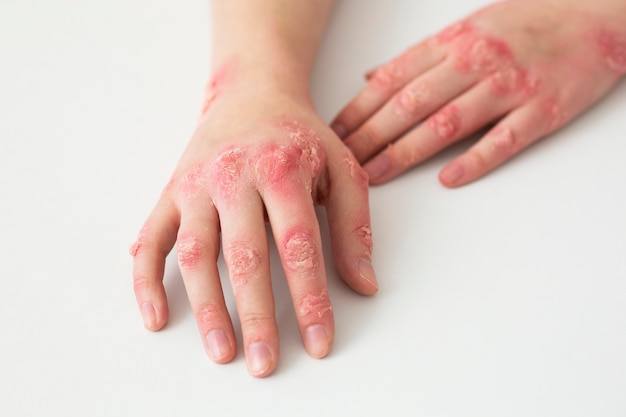Psoriasis is not just a simple rash. It’s a complex condition that touches the lives of millions around the world. If you or someone you know suffers from psoriasis, understanding more about it can be a turning point. This guide aims to shed some light on what causes psoriasis and explore dietary and lifestyle changes that can make a difference. We’ll also look into modern treatment options and try to understand the causes and psoriasis triggers.
Understanding Psoriasis: Causes, Triggers, and Types
Psoriasis is believed to have both genetic and environmental roots. If you have family members with psoriasis, you might be more likely to develop it yourself. But genes aren’t the only players here. Environmental elements like pollution and climate can also play roles in what causes psoriasis.
Several psoriasis triggers can make symptoms appear or worsen. Stress, for instance, is a big one. When life gets hectic, psoriasis tends to flare up. Infections like strep throat, certain medications, and lifestyle habits such as smoking can also spark symptoms.
Wondering about different psoriasis types? Here’s a quick guide:
- Plaque Psoriasis: This is the most common form. It shows up as raised, red patches with a silver-white surface.
- Guttate Psoriasis: Often starts in childhood. It looks like small, pink bumps.
- Inverse Psoriasis: Appears as bright red and shiny lesions in areas where skin meets skin, such as armpits.
- Pustular Psoriasis: Shows up as white pustules surrounded by red skin.
Each type has its own distinct psoriasis signs, but most involve red, itchy skin. Understanding these signs can aid in a proper psoriasis diagnosis.
Navigating Treatment Options: From Topicals to Phototherapy
If you’re dealing with psoriasis, there’s good news. Treatment options abound. Many people start with topicals. These are creams or ointments directly applied to the skin. They can help reduce redness and itching.
Then, there are systemic medications. These are taken by mouth or injected, working from the inside out. They can be effective but might come with side effects, so they require careful consultation with your doctor.
Phototherapy is another popular choice. Think of it as medically supervised sunbathing. It uses UV light to calm the skin. While safe, like a sunbath, it needs to be done under a professional’s eye.
Remember, picking the right treatment is personal. What works for one might not suit another. Continuous check-ups with healthcare professionals are vital to tailor the best plan for you.
In recent years, there have been exciting advancements in psoriasis treatment options. New medicines and support networks are emerging, making management easier. These changes have offered new hope to those living with psoriasis.
Lifestyle Changes and Dietary Recommendations
Managing psoriasis isn’t just about treatment. It’s also about lifestyle. Keeping a balanced diet is crucial. Some foods inflame the body, possibly triggering bla-zing skin episodes—others help calm the storm.
Here are a few dietary tips:
- Eat more fruits and veggies
- Reduce dairy and red meat
- Choose whole grains over refined ones
It’s a good idea to find foods that work for you and stick to them. Besides food, taking care of yourself in other ways is important too.
Next comes lifestyle changes. Stress management is at the top of this list. Techniques like yoga, meditation, and deep breathing can help calm your mind and skin. A strict skincare routine is also key. Moisturizing daily can make a big difference.
Exercise, without overdoing it, plays a role too. It keeps your body in shape and may ease tension, reducing the risk of flair-ups. Recent days have seen the rise of myths around psoriasis. It’s important to separate facts from fiction. Psoriasis is not contagious. Touching someone with psoriasis won’t give you the condition.
Understanding psoriasis symptoms and knowing the psoriasis treatment options makes managing the condition better. This approach not only aids in minimizing your symptoms but also improves overall life quality. So, equip yourself with knowledge and make those small but significant changes.
